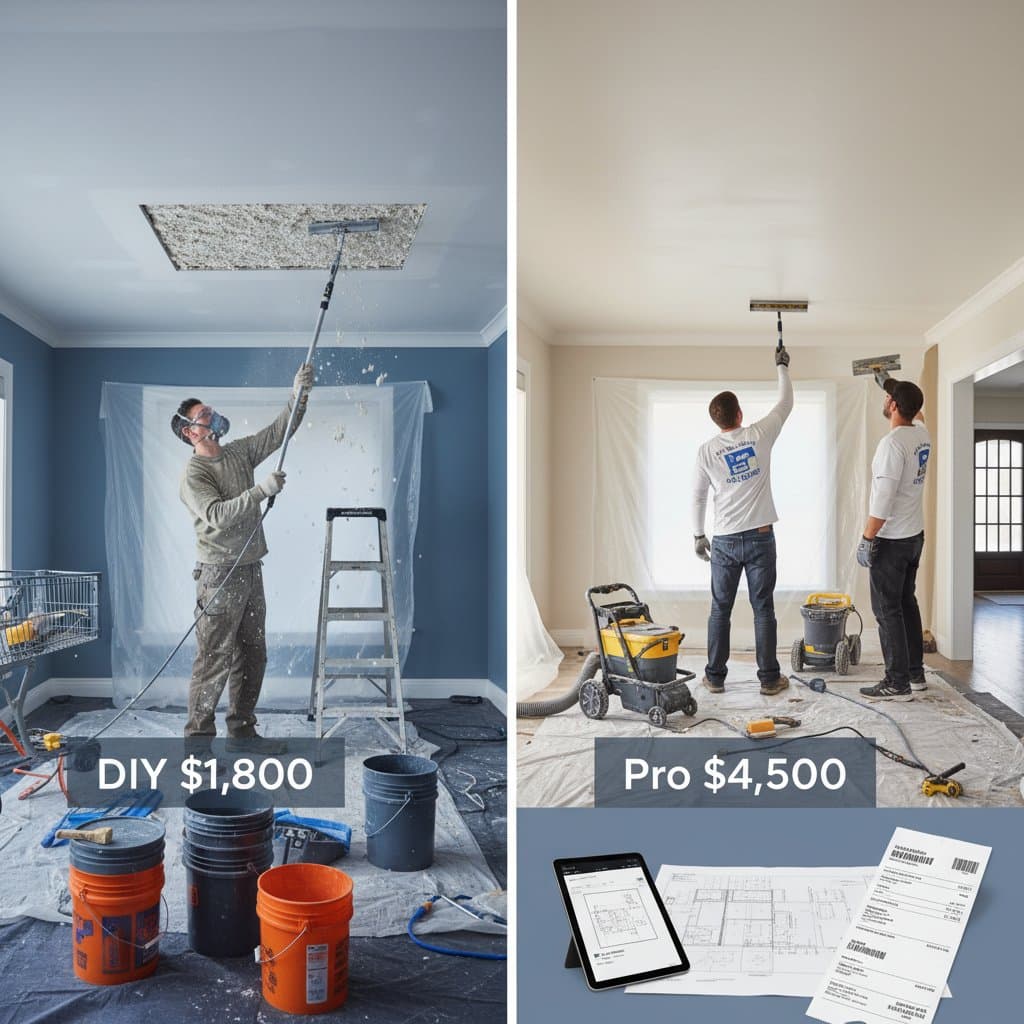Understanding Popcorn Ceiling Removal Costs: DIY at $1,800 Versus Professional Service at $4,500
Popcorn ceiling removal transforms outdated interiors into sleek, contemporary spaces. Homeowners often encounter costs ranging from $1,500 to $5,000 for a complete project. These figures depend on factors such as room size, ceiling texture condition, and potential hazards like asbestos. Homeowners must decide between a do-it-yourself approach, which averages $1,800, and hiring professionals, who charge around $4,500. Grasping the elements that influence pricing enables informed budgeting and selection of the method that aligns with skill level, schedule, and desired outcome.
Cost Ranges Based on Room Size
Room dimensions play a central role in determining overall expenses. Smaller areas require fewer resources, while larger spaces demand more time and materials. Consider these typical ranges:
- Small room (up to 150 square feet): $300 to $900
- Medium room (200 to 400 square feet): $800 to $2,000
- Large room or open area (500 square feet or more): $2,000 to $4,500
For a standard 12-by-12-foot bedroom, expect costs to fall in the medium category. Measure your space accurately to estimate expenses precisely.
Detailed Cost Breakdown per Square Foot
Pricing occurs on a per-square-foot basis, with DIY efforts at $1 to $2 and professional services at $2 to $5. This structure accounts for various project phases. Key components include:
- Materials: $0.25 to $0.75 per square foot, covering scrapers, plastic sheeting, tape, and joint compound for repairs
- Labor: $1.50 to $3.50 per square foot, encompassing surface preparation, texture scraping, and surface smoothing
- Preparation and cleanup: $0.25 to $0.75 per square foot, involving room sealing, debris management, and final tidying
- Additional factors: $0.50 to $1.00 per square foot, addressing asbestos abatement or structural fixes
To calculate your total, multiply the square footage by the appropriate rate and sum the categories. This method reveals where savings opportunities exist.
Service Level Cost Comparison
Different approaches yield varying expense levels. The following table outlines basic, standard, and premium options for clarity.
| Service Type | Basic Range | Standard Range | Premium Range | Key Differences |
|---|---|---|---|---|
| DIY Supplies | $200 - $400 | $400 - $600 | $600 - $900 | Includes basic tools, sheeting, patching compounds, and primer paint |
| Professional Removal | $2,000 - $3,000 | $3,000 - $4,500 | $4,500 - $6,000 | Encompasses skilled labor, thorough cleanup, texturing alternatives, and repairs |
| Asbestos Testing | $50 - $150 | $150 - $300 | $300 - $500 | Required for pre-1980s homes; involves sampling and lab analysis |
| Ceiling Repair and Repaint | $200 - $500 | $500 - $900 | $900 - $1,500 | Features drywall patching, sanding, priming, and multiple coats of finish paint |
Select a service tier based on project complexity. For instance, basic DIY suits simple, small-scale jobs, while premium professional work ensures flawless results in challenging environments.
Evaluating Value and Return on Investment
Beyond immediate costs, consider long-term benefits. Removing popcorn ceilings boosts home appeal, potentially increasing property value by 5 to 10 percent in dated homes. Professional finishes yield superior durability, reducing future maintenance needs. DIY projects offer substantial savings but carry risks of uneven results or health exposures if asbestos lurks undetected.
ROI calculations factor in energy efficiency gains from smoother surfaces that reflect light better, lowering lighting demands. In resale scenarios, updated ceilings attract buyers faster, minimizing time on market. Weigh these advantages against upfront investments to determine the most worthwhile path. For example, a $4,500 professional job in a 300-square-foot living room might recoup 70 percent through enhanced marketability.
Steps to Plan and Budget Effectively
Effective planning prevents budget overruns. Begin by documenting ceiling dimensions and assessing texture age; homes built before 1980 often contain asbestos, necessitating testing. Obtain quotes from at least three licensed contractors, ensuring inclusions for preparation, removal, and refinishing.
Allocate 10 to 15 percent of the estimate for contingencies like unexpected repairs. Source materials from reliable suppliers to avoid subpar quality that leads to rework. Time the project for off-peak seasons, such as late winter, when contractors offer discounts due to lighter schedules.
For DIY enthusiasts, assemble a toolkit including a sturdy ladder, wide scrapers, and safety gear. Practice on a small section to gauge feasibility. If opting for professionals, verify insurance and references to safeguard against liabilities.
Frequently Asked Questions
What is the average cost for popcorn ceiling removal?
Homeowners typically spend between $1,500 and $5,000. Do-it-yourself projects average $1,800, while professional installations reach $4,500 on average. These amounts vary with room size and complexity.
Which factors most significantly affect popcorn ceiling removal costs?
Ceiling condition, asbestos presence, height, existing paint layers, and local labor rates exert the greatest influence. Damaged or painted surfaces demand extra effort, elevating expenses compared to pristine, unpainted ones.
How can homeowners reduce costs on popcorn ceiling removal while maintaining quality?
Perform preparation and cleanup tasks independently. Schedule work during non-peak periods for better rates. Combine removal with broader painting efforts to leverage economies of scale. Purchase supplies in bulk from wholesale outlets to trim material outlays.
Is professional hiring preferable to a DIY approach for popcorn ceiling removal?
DIY works well for compact, unpainted ceilings free of asbestos. Larger or intricate areas benefit from professional expertise, which delivers quicker completion, reduced mess, and minimized damage risks.
How should one prepare for unforeseen expenses in popcorn ceiling removal?
Reserve 10 to 15 percent of the project budget for issues like concealed cracks or additional refinishing. Conduct preliminary inspections to identify potential problems early.
When does scheduling popcorn ceiling removal yield the lowest costs?
Late winter through early spring provides optimal timing. Contractors face fewer bookings then, leading to negotiable pricing and prompt service.
Secure a Smooth, Updated Ceiling on Budget
Popcorn ceiling removal elevates home aesthetics without excessive strain on finances. By comparing DIY and professional options, homeowners access tailored strategies for success. Implement these insights to achieve a refreshed interior that enhances daily living and property worth.



